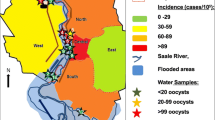Abstract
Background
In late Spring 2012, 12 cases of cryptosporidiosis in a town in the South East of Ireland were notified to the regional Department of Public Health.
Aim
The purpose of this paper is to describe the outbreak and the investigative process which led to the conclusion that the source was a public drinking water supply.
Methods
Outbreak and incident control teams were convened to investigate and control the outbreak.
Results
Eleven cases were speciated as Cryptosporidium parvum. GP60 analysis demonstrated that 10 were C. parvum IIaA20G3R1, indicating that the cases were linked. The public water supply was the only common risk factor identified. Increased water sampling identified Cryptosporidium muris/andersoni in the treated water at one of two water treatment plants (Water Treatment Plant, WTP A) for the supply, and on the network. C. parvum was subsequently identified in raw water from WTP A.
Conclusions
The Health Service Executive (HSE) concluded that this outbreak was “probably associated with water” produced at WTP A based on (1) descriptive epidemiological evidence suggesting water-related illness and excluding other obvious explanations; and (2) water treatment failure at WTP A. WTP A was closed to facilitate an upgrade. No boil water notice was required as a supplementary supply was available. The upgrade was completed and the incident closed in 2013.

Similar content being viewed by others
References
Bouzid A, Hunter PR, Chalmers RM, Typer KM (2013) Cryptosporidium pathogenicity and virulence. Clin Microbiol 26(1):115–134
Cacciò SM (2005) Molecular epidemiology of human cryptosporidiosis. Parassitologia 47(2):185–192
Chalmers RM, Smith R, Elwin K, Clifton-Hadley FA, Giles M (2011) Epidemiology of anthroponotic and zoonotic human cryptosporidiosis in England and Wales, 2004–2006. Epidemiol Infect 139(5):700–712
Strong WB, Gut J, Nelson RG (2000) Cloning and sequence analysis of a highly polymorphic Cryptosporidium parvum gene encoding a 60-kDa glycoprotein and characterization of its 15- and 45-kDa zoite surface antigen products. Infect Immun 68(7):4117–4134
Zintl A, Ezzaty-Mirashemi M, Chalmers RM et al (2011) Longitudinal and spatial distribution of GP60 subtypes in human cryptosporidiosis cases in Ireland. Epidemiol Infect 139:1945–1955
Chalmers RM, Smith RP (2011) Zoonotic linkage and variation in Cryptosporidium parvum from patients in the United Kingdom. Parasitol Res 108:1321–1325
Glaberman S, Moore JE, Lowery CJ et al (2002) Three drinking-water-associated cryptosporidiosis outbreaks, Northern Ireland. Emerg Infect Dis 8(6):631–633
McKerr C, Adak GK, Nichols G et al (2015) An outbreak of Cryptosporidium parvum across England and Scotland associated with consumption of fresh pre-cut salad leaves, May 2012. PLoS One 10(5):e0125955. doi:10.1371/journal.pone.0125955
World Health Organization (2002) Water and Health. A joint report from the European Environmental Agency and the WHO Regional Office for Europe. In: Bartram J, Thyssen N, Gowers A, Pond K, Lack T (eds) WHO Regional Publications Series no. 93:122, WHO, Finland
HSE (2005) Outbreak Control Team report on Cryptosporidiosis outbreak in Carlow town and environs. http://www.lenus.ie/hse/handle/10147/42923. Accessed 24 May 2016
HPSC. Cryptosporidiosis Enhanced Surveillance Form V 1.0, September 2010. http://www.hpsc.ie/A-Z/Gastroenteric/Cryptosporidiosis/SurveillanceForms/. Accessed 24 May 2016
Environmental Protection Agency (2011) EPA Drinking Water Advice Note. Advice Note No. 9: Cryptosporidium Sampling and Monitoring, Version 1. Dublin: EPA
Peng MM, Matos O, Gatei W et al (2001) A comparison of Cryptosporidium subgenotypes from several geographical regions. J Eukaryot Microbiol 48(Suppl):28s–31s
Alves M, Xiao L, Sulaiman I, Lal AA, Matos O, Antunes F (2003) Subgenotype analysis of Cryptosporidium isolates from humans, cattle and zoo ruminants in Portugal. J Clin Microbiol 41(6):2744–2747
Chalmers RM, Ferguson C, Cacciò SM et al (2005) Direct comparison of selected methods of genetic characterisation of Cryptosporidium parvum and Cryptosporidium hominis species. Int J Parasitol 35(4):397–410
Hawker J, Begg N, Blair I, Reintjes R, Weinberg J, Ekdahl K (2012) Communicable disease control and health protection handbook, 3rd edn. Wiley-Blackwell, Oxford
National Disease Surveillance Centre (2004) Report of the Waterborne Cryptosporidiosis Subcommittee of the Scientific Advisory Committee. NDSC, Dublin
Xiao L, Fayer R, Ryan U, Upton SJ (2004) Cryptosporidium taxonomy: recent advances and implications for public health. Clin Microbiol Rev 17(1):72–97
Thompson HP, Dooley JSG, Kenny J et al (2007) Genotypes and subtypes of Cryptosporidium spp. in neonatal calves in Northern Ireland. Parasitol Res 100:619–624
Karanis P, Kourenti C, Smith H (2007) Waterborne transmission of protozoan parasites: a worldwide review of outbreaks and lessons learnt. J Water Health 5(1):1–38
Chalmers R (2012) Waterborne outbreaks of cryptosporidiosis. Ann Ist Super Sanità 48(4):429–446
Widerstorm M, Schönning C, Lilja M et al (2014) Large outbreak of Cryptosporidium hominis infection transmitted through the public water supply, Sweden. Emerg Infect Dis 20:581–589
Pelly H, Cormican M, O’Donovan D et al (2007) A large outbreak of cryptosporidiosis in western Ireland linked to a public water supply: a preliminary report. Euro Surveill 12(5):E070503.3
World Organisation for Animal Health (2014) Manual of Diagnostic Tests and Vaccines for Terrestrial Animals. Paris: OIE. http://www.oie.int/international-standard-setting/terrestrial-manual/access-online/. Accessed 24 May 2016
Author information
Authors and Affiliations
Corresponding author
Ethics declarations
Funding
Grant funding was not required for this paper.
Conflict of interest
Dr. Marrita Mahon declares that she has no conflict of interest. Dr. Sarah Doyle declares that she has no conflict of interest.
Ethical approval
This article does not contain any studies with human participants or animals performed by any of the authors.
Rights and permissions
About this article
Cite this article
Mahon, M., Doyle, S. Waterborne outbreak of cryptosporidiosis in the South East of Ireland: weighing up the evidence. Ir J Med Sci 186, 989–994 (2017). https://doi.org/10.1007/s11845-016-1552-1
Received:
Accepted:
Published:
Issue Date:
DOI: https://doi.org/10.1007/s11845-016-1552-1




